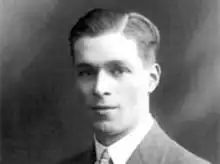James Curtis | |
|---|---|
 | |
| Born | Geoffrey Basil Maiden 4 July 1907 Sturry, Kent |
| Died | 1977 Camden, London |
| Resting place | St Pancras, London |
| Occupation | Novelist, Screenwriter |
| Notable works | The Gilt Kid, There Ain't No Justice, They Drive By Night |
James Curtis (4 July 1907 – 1977) was a British writer who was best known for his novels, They Drive By Night and There Ain't No Justice, both of which were made into feature films.
Life
James Curtis was born Geoffrey Basil Maiden, in Sturry, Kent on 4 July 1907.[1] He was privately educated in Kent and after leaving school he moved to London.[2] In 1934, Curtis appeared in two films, Manhattan Melodrama and Fugitive Lady, in uncredited roles.[3]
He later adopted the pseudonym of James Curtis and began a career as an author. In total he wrote six novels as well as, at least, one work of political observations. [4]
Curtis was forced to stop writing when World War II broke out. He would go on to tour France and Burma and rose to the rank of Major. After the war, his marriage had failed and his literary momentum never recovered.[5]
Works
Curtis used his plots to highlight society's unfairness and the lack of opportunity that often led people to break the law in times of poverty.[6] The lexicographer Eric Partridge frequently cited Curtis as a source of new slang words in his A Dictionary of Slang and Unconventional English.[7]
His debut novel The Gilt Kid was published in London by Jonathan Cape in 1936 and reissued in 1947 as no.623 in the Penguin main series.[8]
In 1937 he published two novels, You’re in the Racket Too and There Ain't No Justice. [9] You’re in the Racket Too is notable for being one of the earliest examples in print of the expression ”Gordon Bennett!”[10] [11] 1937 also saw the publication of his only non-fiction work, A Guide to British Liberties, featuring left-wing political observations.[12]
In 1938 he published his fourth novel, They Drive By Night followed in 1939 by his penultimate novel, What Immortal Hand.[13]
After a 17-year absence he published his final published work in 1956, the novel Look Long Upon a Monkey.
In 2007, London Books republished his 1936 novel, The Gilt Kid to coincide with the 30th anniversary of his death.[14] It featured an interview with his daughter, Nicolette Edwards. In 2008 a reissue of They Drive By Night followed as part of their London Classics series.[15] In 2014 There Ain't No Justice was published by London Books as their tenth London Classic. The contemporary introduction was written by Martin Knight.
Adaptations
In 1938, They Drive By Night was released as a feature film with the screenplay provided by Curtis himself. It was directed by Arthur Woods and starred Emlyn Williams and Ernest Thesiger.[16]
The following year his second novel was made into a film of the same name, There Ain't No Justice (1939). The author again provided the screenplay with Pen Tennyson acting as director.[17]
Death
In 1977, James Curtis died in Camden, North London after suffering a heart attack in a chemist shop. He is buried in St Pancras cemetery.[18]
Bibliography
Novels
- The Gilt Kid (1936)
- You’re in the Racket Too (1937)
- There Ain't No Justice (1937)
- They Drive By Night (1938)
- What Immortal Hand (1939)
- Look Long Upon a Monkey (1956)
Screenplays
- They Drive by Night (1938)
- There Ain't No Justice (1939)
- Ten Days in Paris (1940)
References
- ↑ James Curtis, BFI
- ↑ James Curtis Biography, London Books
- ↑ James Curtis, IMDB
- ↑ James Curtis, Fantastic Fiction
- ↑ "Underworld Kid is back", Camden New Journal
- ↑ The Gilt Kid, Paul Willetts
- ↑ "Carving a career in style", Jonathan Meades Archived 29 September 2009 at the Wayback Machine
- ↑ The Gilt Kid, Lost London Literature
- ↑ There Ain't No Justice, Lost London Literature
- ↑ "Revealed: real Gordon Bennett", London Evening Standard
- ↑ "Gordon Bennett: A puzzling British exclamation", World Wide Words
- ↑ "They Drive By Night, John King". Archived from the original on 28 February 2020. Retrieved 20 June 2010.
- ↑ They Drive By Night, Lost London Literature
- ↑ The Gilt Kid, Paul Willetts
- ↑ "They Drive By Night, John King". Archived from the original on 28 February 2020. Retrieved 20 June 2010.
- ↑ They Drive By Night, IMDB
- ↑ There Ain't No Justice, IMDB
- ↑ "Underworld Kid is back", Camden New Journal